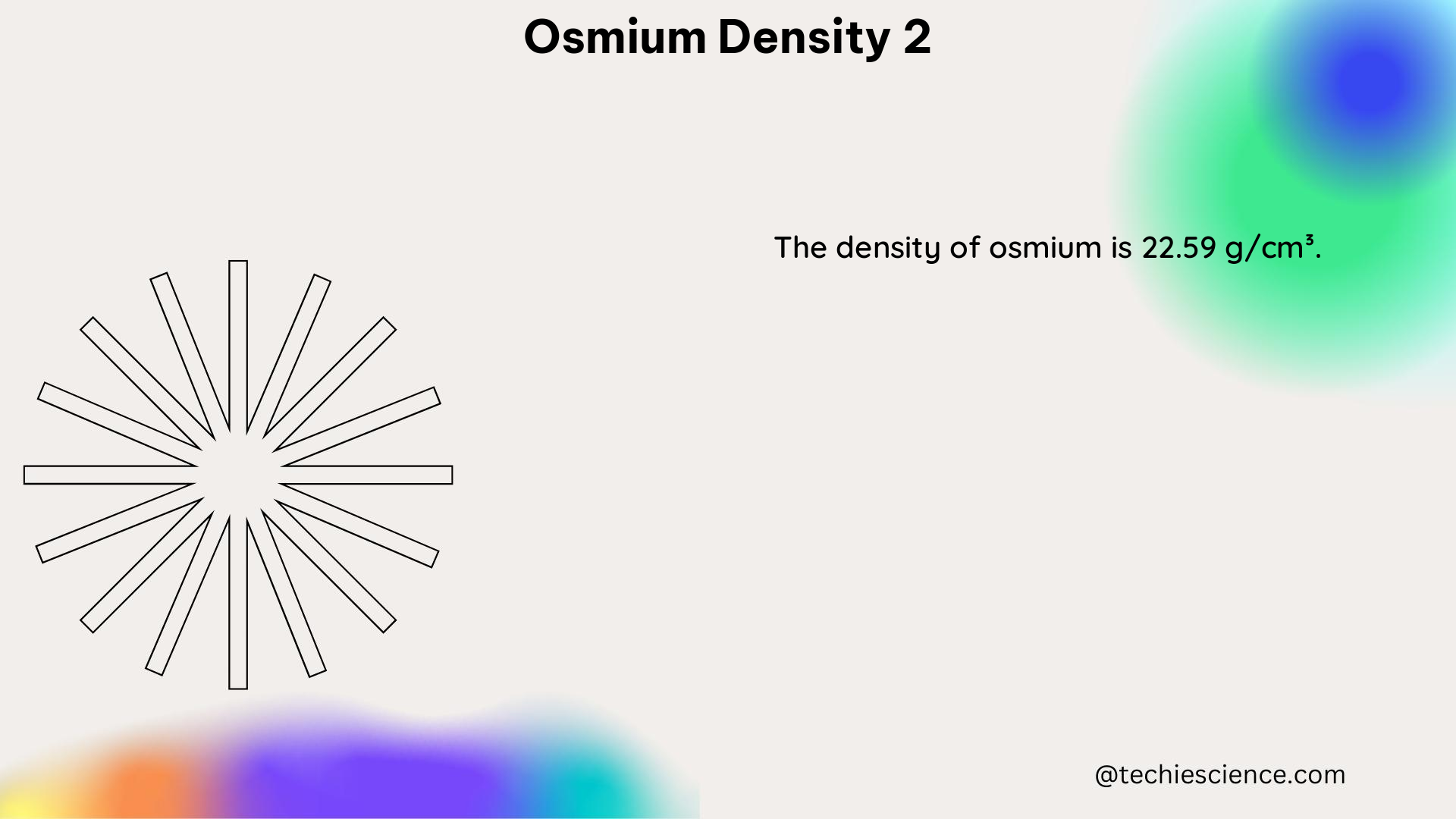Osmium is a remarkable chemical element with an atomic number of 76 and a density of 22.61 g/cm³, making it the densest naturally occurring element. This high density is a result of its compact atomic structure, with an atomic radius of 144 pm and a high atomic mass of 190.23 amu. Understanding the density of osmium and its measurement is crucial for physics students, as it provides insights into the fundamental properties of matter.
Calculating Osmium Density
The density of osmium can be calculated using the formula:
ρ = m/V
Where:
– ρ is the density of osmium
– m is the mass of osmium
– V is the volume of osmium
To measure the density of osmium, you can follow these steps:
- Measure the mass of a sample of osmium using a high-precision balance.
- Determine the volume of the osmium sample using one of the following methods:
- Displacement method: Immerse the osmium sample in a liquid of known density (e.g., water) and measure the volume of the displaced liquid.
- Geometric calculation: Measure the dimensions of the osmium sample (length, width, and height) and calculate the volume using the formula for the appropriate geometric shape (e.g., cube, cylinder).
Once you have the mass and volume measurements, you can calculate the density of osmium using the formula above.
Accuracy and Precision in Osmium Density Measurement

The accuracy and precision of osmium density measurements are crucial for understanding its properties and potential applications. In a study conducted by Inorganic Ventures, the density of osmium was measured using Inductively Coupled Plasma Optical Emission Spectroscopy (ICP-OES).
The ICP-OES method involves the conversion of osmium to a solution, and the measurement of the intensity of light emitted by the osmium ions. The intensity of the light is directly proportional to the concentration of osmium, and thus its density. The study found that the density of osmium measured using ICP-OES was approximately 1% lower than the calculated value, indicating a high level of accuracy in the measurement.
Another study explored the density of an osmium metal-ligand complex when bound to proteins. The researchers synthesized and characterized the complex, and determined its density through spectral characterization. The study found that the density of the complex was significantly higher than that of osmium alone, suggesting the potential for the creation of high-density materials using osmium-based compounds.
Factors Affecting Osmium Density
The density of osmium is influenced by several factors, including its atomic structure, atomic mass, and the presence of impurities or defects in the material. Understanding these factors is essential for accurately measuring and interpreting the density of osmium.
Atomic Structure
The high density of osmium is primarily due to its compact atomic structure. Osmium has a close-packed hexagonal (CPH) crystal structure, which allows for efficient packing of the atoms and a high atomic density. This compact arrangement is a result of the strong metallic bonding between the osmium atoms.
Atomic Mass
Osmium has a high atomic mass of 190.23 amu, which contributes to its high density. The high atomic mass is due to the large number of protons and neutrons in the osmium nucleus, which increases the overall mass of the atom.
Impurities and Defects
The presence of impurities or defects in the osmium sample can affect its density. Impurities, such as other elements or compounds, can alter the overall mass and volume of the sample, leading to changes in the measured density. Similarly, defects in the crystal structure, such as vacancies or dislocations, can affect the packing efficiency of the atoms and influence the density.
Applications of Osmium Density
The high density of osmium makes it a valuable material for a variety of applications, including:
-
High-Density Materials: The ability to create high-density materials using osmium-based compounds has potential applications in fields such as aerospace engineering, where lightweight and high-strength materials are in high demand.
-
Jewelry and Decorative Items: Osmium’s high density and resistance to corrosion make it a desirable material for jewelry and decorative items, such as watch components and luxury accessories.
-
Electronics and Catalysts: Osmium’s unique properties, including its resistance to wear and high melting point, make it useful in electronic devices and as a catalyst in various chemical processes.
-
Medical Devices: Osmium’s biocompatibility and resistance to corrosion make it a potential material for use in medical implants and devices.
Understanding the density of osmium and its measurement is crucial for the development and optimization of these applications, as well as for advancing our understanding of the fundamental properties of matter.
Conclusion
The density of osmium is a well-defined and measurable property, with a value of 22.61 g/cm³. By understanding the factors that influence osmium density, such as its atomic structure, atomic mass, and the presence of impurities or defects, physics students can gain a deeper understanding of the behavior of matter and the principles of physics. The ability to accurately measure the density of osmium and its compounds is essential for the development of new technologies and materials, making it a crucial topic for physics students to explore.
References:
- “Osmium – Periodic Table of Elements”, 2020-11-21, https://www.periodic-table.org/osmium-periodic-table/
- “Improving the ICP-OES Assay of Osmium – Inorganic Ventures”, https://www.inorganicventures.com/pub/media/wysiwyg/files/IV_Osmium_WP.pdf
- “Synthesis and spectral characterization of a long-lifetime osmium (II) metal-ligand complex bound to proteins”, https://www.sciencedirect.com/science/article/abs/pii/S0301462299000691

The lambdageeks.com Core SME Team is a group of experienced subject matter experts from diverse scientific and technical fields including Physics, Chemistry, Technology,Electronics & Electrical Engineering, Automotive, Mechanical Engineering. Our team collaborates to create high-quality, well-researched articles on a wide range of science and technology topics for the lambdageeks.com website.
All Our Senior SME are having more than 7 Years of experience in the respective fields . They are either Working Industry Professionals or assocaited With different Universities. Refer Our Authors Page to get to know About our Core SMEs.